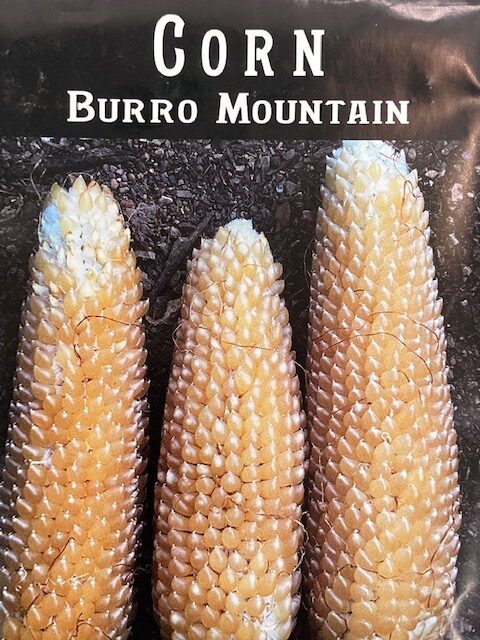
Popcorn
Popcorn comes in many colors, from classic white to purple and blue. It is fun to grow and is a tasty treat.
|
Burro Mountain |
|
Zea mays everta |
|
Intermediate |
|
Intermediate |
|
3 years if properly stored |
|
Annual |
|
7-10 days |
|
None |
|
1.5 – 2 inches |
|
4-6′ tall |
|
Full Sun |
|
2-3 ears per stock 4-6” long |
|
85-95 days |
|
April and May |
|
Yes |

Growing Tips

When to Start
Spring: Direct sow when soil temps are between 60-90 F and at least 2 weeks after the last average killing frost. (Mar 15-Jun 1 for GA. Mid-May for Jefferson, GA)
How to Start
Try the 3 Sisters Method. You can also just use the mounds for the popcorn or use 6 rows with 24-36 inches between rows. Corn is a warm-season vegetable requiring soil temperatures between 60-90 degrees. Avoid planting seeds in cool soils. Wait until at least two weeks after the last average killing frost before planting. If planted too early, weak stands, stunted growth or frost-killed seedlings may result.
Choose a sunny area. Corn needs 8-10 hrs of full sun. Prepare the soil by breaking it up and raking the soil. Next, build a mound about 12 inches high and between 18 inches and 3 feet in diameter. Mounds should be 3 to 4 feet apart in all directions.
Care
Water is vital to ensure a good stand of corn. Corn requires a minimum of 1 inch of water per week for normal development. The most critical periods for water are during pollination and final ear filling. Water slowly and deeply to moisten the soil to a depth of 6 inches. Irrigate in the early morning or early evening to allow foliage to dry before dark. Soaker hoses placed alongside rows are an excellent way to irrigate corn and conserve water.
Soak four to seven corn seeds overnight and then plant them about 6 inches apart in the center of each mound. (You’ll eventually thin to three or four seedlings.) After a week or two, When the corn is at least 4 inches high, plant beans and squash. Soak six pole bean seeds and plant them in a circle about 6 inches away from the corn. (You’ll eventually thin to three or four bean seedlings.) At about the same time, plant four squash or pumpkin seeds next to the mound, about a foot away from the beans, eventually thinning to one.
If you are planting a large area, you can also sow the squash in separate mounds (1 foot in diameter) between every few corn and bean mounds.
As corn plants grow, weed gently around them and mound soil around the base of each stem for support. When the corn is knee-high and again when silks appear on the husks, “side dress” by putting a high nitrogen fertilizer on the soil surface near each plant. If beans aren’t winding their way around the corn, move the tendrils to the stalks. To allow room for corn and beans to grow, gently direct squash vines into walkways, garden edges, or between mounds. If you pinch off the tips of squash runners after several fruits have started to form, the plants will devote more energy to producing squash.
Harvest
Allow the corn to fully mature on the stocks. Harvest when the stocks are brown and dry and the kernels hard and dry. Just pick them before a frost.
Pull the husks all the way down so that they aren’t fully removed and can be tied together. Group several cobs together, tie the husks, and hang them upside down in a warm place for 2-3 weeks. This will allow the cobs to fully dry.
After they are fully dry, rub the cobs together to remove the kernels for storage.
Seed Saving

Isolation Distance
All corn is wind pollinated and will cross with other varieties. Isolate varieties by 1-2 miles.
Instructions
Leave ears on the stalk until the husks dry and turn brown. Harvest them as soon as they are dry as rain will cause rot or sprouting. If you’re worried about birds, tie a paper bag over them and secure it with a string.
Remove and peel back the husks and hang them to dry, out of direct sunlight, for a month. Once they’re dry, remove the individual kernels.
Visually inspect each kernel to ensure that they are intact and bugs haven’t gotten to them.
Once the seeds are dry they can be used for replanting or popping.
Features
Burro Mountain: “A unique appearance and delicious flavor make this a standout popcorn. It was originally found in a pottery container dated to be 600 to 1,000 years old. This pot was found in the Burro Mountains of Grant County, New Mexico, in the 1960s/1970s by Frank Tatsch, who originally grew it out. The popcorn is believed to be descended from an ancient highland popcorn, called Palomero Tolequero, indigenous to Mexico. This Palomero popcorn is nearly extinct and was used in Aztec rain and war ceremonies. It is one of the ancestors to almost all of our popcorn in the United States. This strain grown in the Burro Mountains centuries ago was once considered extinct until its discovery in the pot.” (rareseeds.com)
